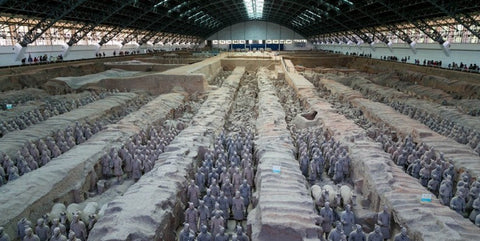The Mausoleum of Emperor Qin Shi Huang

A 56 square km site, where the First Emperor of China was buried, accompanied by thousands of terracotta warrior statues. This is what the Mausoleum of Emperor Qin Shi Huang is.
Who is Qin Shi Huang (秦始皇)? 🐲
Who is Qin Shi Huang (秦始皇)? 🐲

Qin Shi Huang is the first emperor of the dynasty Qin , also known as the first Emperor of China.
He is a notable figure in Chinese history .
Indeed, it was he who in 221 BC. JC , unified all the different kingdoms of that time into a single empire, the Empire of China .
During his reign, he standardized writing , language, currency, weights and measures and is also considered the father of the famous Great Wall of China .
Her Mausoleum
He is a notable figure in Chinese history .
Indeed, it was he who in 221 BC. JC , unified all the different kingdoms of that time into a single empire, the Empire of China .
During his reign, he standardized writing , language, currency, weights and measures and is also considered the father of the famous Great Wall of China .
Her Mausoleum

However, today he is also known for something else that fascinates archaeologists and the public alike.
I am talking here about his incredible and monumental mausoleum located near Xi An (Northwest China), where he was buried, accompanied by thousands of terracotta warrior statues on a site of no less than 56 square km.
I am talking here about his incredible and monumental mausoleum located near Xi An (Northwest China), where he was buried, accompanied by thousands of terracotta warrior statues on a site of no less than 56 square km.

His tomb, which has not been excavated, rests under a river of mercury, covered by a tumulus 75 to 115 meters high depending on the sources and ditches comprising 8,000 terracotta statues of soldiers and horses.
A reproduction of his army that he had made to accompany him in the afterlife and almost all having a different face.
According to the historical memoirs of the historian Sima Qian, the construction of the mausoleum would have required no less than 700,000 workers over thirty-six years!
A terracotta army which was also listed as a UNESCO world heritage site on December 11, 1987.
A reproduction of his army that he had made to accompany him in the afterlife and almost all having a different face.
According to the historical memoirs of the historian Sima Qian, the construction of the mausoleum would have required no less than 700,000 workers over thirty-six years!
A terracotta army which was also listed as a UNESCO world heritage site on December 11, 1987.

A truly fascinating mausoleum with many things still to be discovered ...
